Last week I took Tonka to Tufts (Cummings Veterinary Medical Center Hospital for Large Animals) to get a clear diagnosis about what was causing his front left intermittent lameness. This is the fourth time that Dr. Bubeck has seen Tonka. In previous visits, Dr. Bubeck has diagnosed neck arthritis, bursitis in the poll, sacroiliac joint inflammation and hock arthritis. This appointment was for that pesky left front. Tonka was trotted out on a hard surface and lunged in a soft arena. He was clearly off.
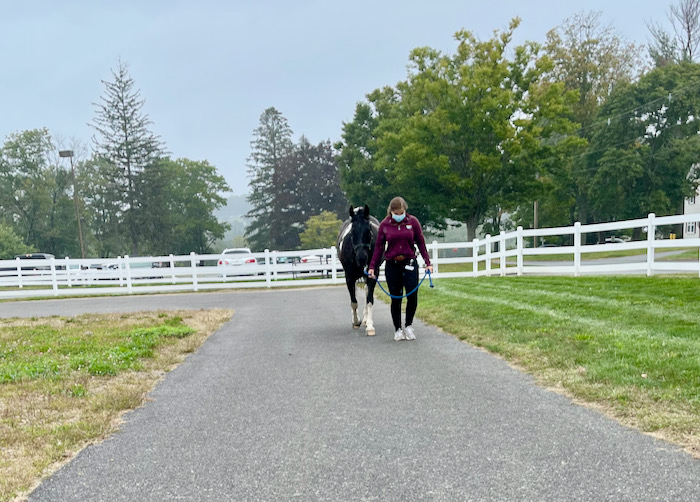
Although my veterinarian, Dr. Monika Calitri, has portable ultrasound and X-ray machines, the ones at Tufts can get deeper and clearer images. So, that’s what Dr. Bubeck did next. We were hoping that would give us all of the information needed, but the results were ambiguous. Adhesions and increased joint fluid could be seen, but they were so mild that perhaps there was something else? I agreed to have Tonka stay another day to have an MRI.
MRI requires the horse to go under general anesthesia, which carries risks, and is expensive. But without the information that the MRI provides, I wouldn’t have an informed way to rehab Tonka. I didn’t want to guess at what might work, I wanted an effective plan.
It was hard for me to leave my horse overnight, but Tonka walked away with his entourage with no issues. All of the work and time that I’ve put into our relationship has paid off. Tonka is confident, curious and trusting.

The MRI did provide more information, but it wasn’t as clearcut as we would have liked. The word “moderate” was used a lot in the report. He has moderate inflammation of the coffin joint, small lesions on the deep flexor tendon and mild inflammation of the medial collateral ligament of the coffin joint. Many horses with these issues are never diagnosed. They go about their lives traveling mostly alright, possibly a tad gimpy, but not complaining, until something breaks catastrophically. But I have a horse who knows that if something is ouchy, that he can tell me. I’m glad he’s not a “stoic” horse because we stopped working before he hurt himself further. Rehab will be only 6 weeks. Not months and months, or a year, like some horses that keep on going until they are broken.
The plan going forward is that Tonka will receive a course of 3 doses of IRAP. (His own blood is processed to create an effective alternative to corticosteroids.)
Tonka got new shoes to support the affected area. (Note that my very good horse ground ties while being shod.)
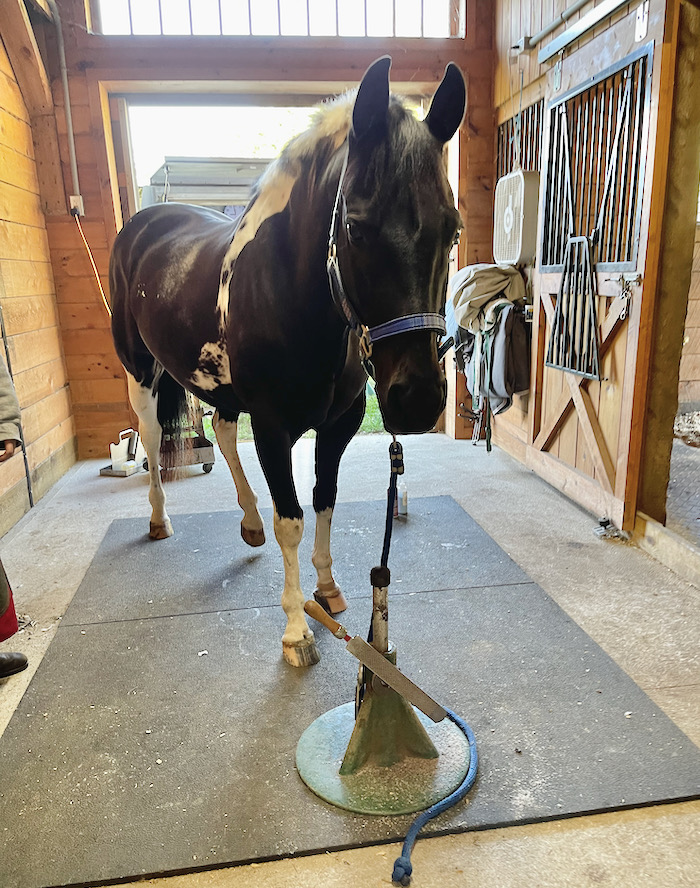
Thank goodness I have the talented farrier, Rebecca Watts. She takes a stock shoe, heats it in her forge and hammers it to fit exactly as needed. There’s also cushioning and a leather pad. He has a matching shoe on his right foot to stay balanced. Meanwhile, because Tonka won’t be in work, we’re letting his hind feet go bare.
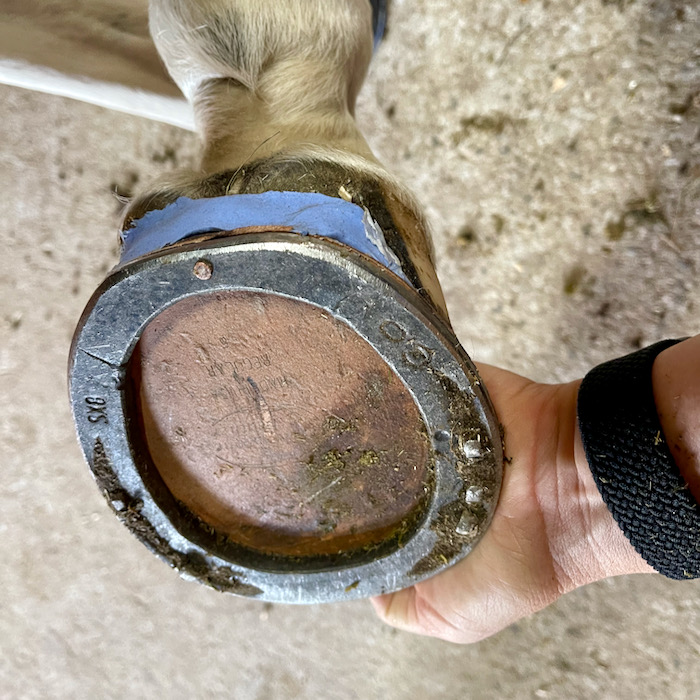
Tonka needs to rest those joints, tendons and ligaments that are deep down in his left hoof. Fortunately, his case is mild and he doesn’t have to be on total stall rest. I can hand-graze him as much as I want. It’s never as much as Tonka wants!

He will be hand-walked 15 minutes everyday. In a couple of weeks, I will be walking him from the saddle.
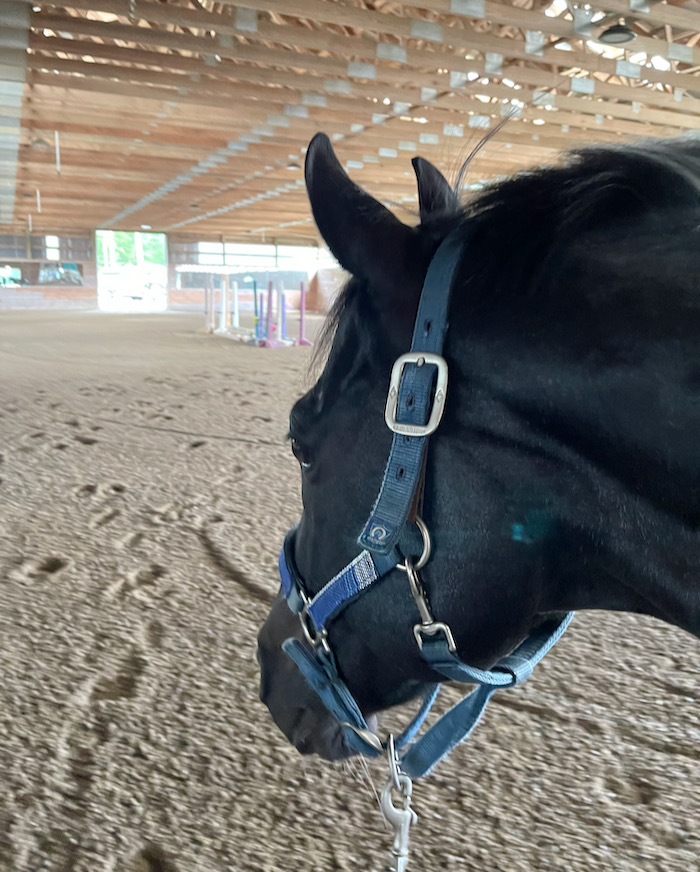
Otherwise, Tonka has to stay in his stall. Fortunately for Tonka, he has a runout, which Dr. Bubeck says he can use. It helps that Tonka is such a sane horse. He’s not going to bounce around out there.
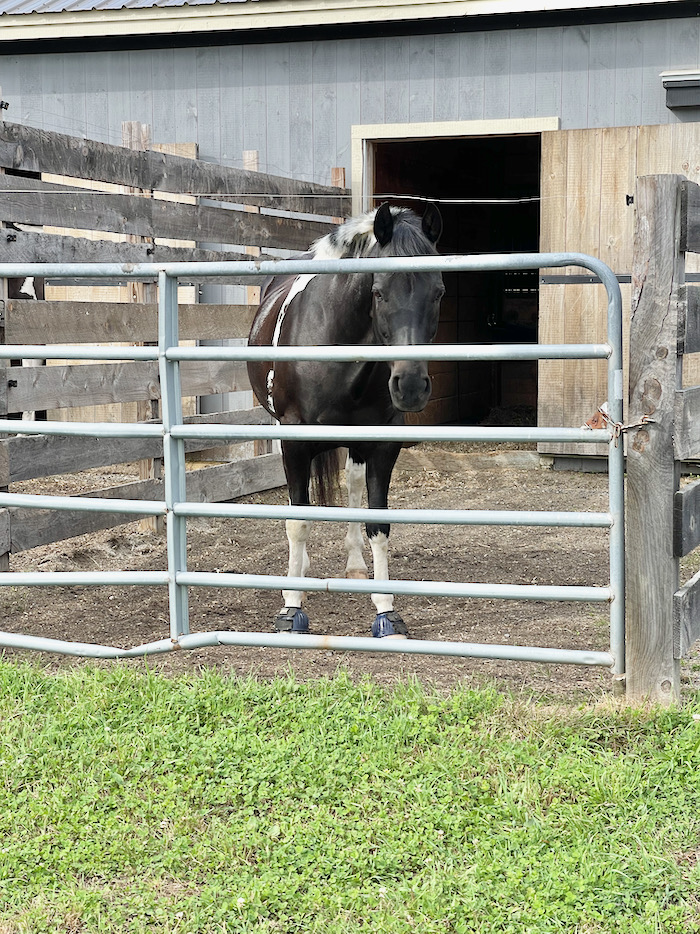
Still, it’s boring! I got Tonka a Lick-it, which, after this initial interaction, he finds barely interesting, even with the sugary center.
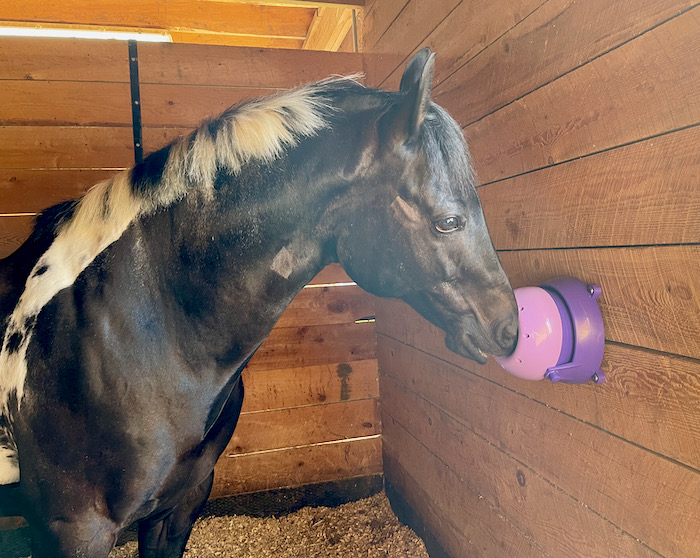
He’d much rather lick me.
Dr. Bubeck says that there’s still a chance that the adhesions on the deep digital flexor tendon are more serious that the MRI shows. If Tonka doesn’t trot out sound in two weeks, he will need surgery for her to fix that. Fingers crossed that’s not the case!
I’ve posted about his lameness before, under the heading of “coffin joint injections.” Over the last year, Dr. Calitri, with the information that she had, did a couple of courses of coffin joint injections. Each time, Tonka went more soundly after. Dr. Bubeck says that those treatments helped to prevent the issues from becoming severe. So, although they didn’t fix things, they did help in the long run!
Has your horse had deep digital flexor tendon, collateral ligament, or coffin joint bursitis? Let me know in the comments!


Thank goodness for you. You are remarkable!
Thanks!
Hey Terry – I’m sure you’re aware of the modality and may have even used it, but I highly recommend PEMF/Magnawave therapy. It’s been a godsend with various issues on my horse and other horses that are at my barn. Thought I’d mention it in case you weren’t aware and interested. Check out https://magnawavepemf.com/practitioners/find-a-practitioner/ to find a certified practitioner near you.
All best wishes to you & Tonka!
Jenn
I tend to be a skeptic, though am sure that there are some successful applications 🙂 In any case, I have to stay well away from such modalities – it totally messes with medical devices like my cochlear implants. Same for people with pacemakers, etc.
I don’t have a horse but I do have bursitis of the right knee, does that count! I hope this will help Tonker become sound again. He is lucky to have you on his case.
Bursitis does count. Give yourself more time to recover than you think so that it’ll truly heal.
Sending thoughts and prayers for Tonka!
Reading this having just left the hospital myself after a surgical procedure today.
Here’s to fast (and correct) recoveries!
We have a farm in KY we’re prepping for horses after previous owners seriously neglected the soil. Love reading your blog as I dream about a Tonka of my own. 🙂
Best wishes for your successful recovery. Horse (and their manure) are great for neglected soil.
As you know, I do not have a horse but love your blog as a portal to the equestrian world. Sending all my hopes for Tonka’s complete recovery. And I couldn’t agree more with the others: he is sooooo lucky to have you as an advocate. Take care.
I’m lucky to have him 🙂
Heal well Tonka! I can’t wait to hit the trails with you again!
I have read your work for many years. Extending back to the chickens, dogs and goats. I respect your approach to interacting with all animals. Kindness is the only acceptable answer..
But a gut feeling has been weighing on me. I have wanted to have this conversation with you for a long time. It would be best in person. I live in California so that can not happen.
Horses are herd animals and do best living in an established herd with space to graze, bond and exercise. Maybe going forward that is the best way to humanely care for them. Maybe Tonka’s chronic pain is because horses were not actually created for humans to ride upon.
Humans constructed the idea that horses could be used to get us quickly from here to there. But perhaps that is an antiquated view.
We could still enjoy the quiet companionship of these beautiful animals. Our horses could dwell in cohesive stable herds with us as the caretakers.
As humans become more aware of what is humane perhaps one day it will be illegal to ride on any animal.
I’m not going to defend what I do here. That “discussion” usually has no-one changing their perspective. I will say that I hope that it will not become illegal to ride horses. I am also not a vegan, and believe one can be a moral and kind individual and still have farm animals. I believe that dogs can have working lives. I believe that well-managed zoos and aquariums are good and essential places. My blog is a place where I try very hard not to proselytize. I just tell some stories and hope that the underlying meaning is heard.